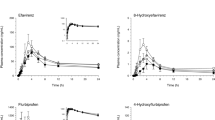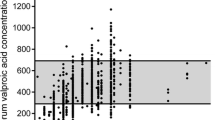Abstract
Background and objective
The metabolic activity of cytochrome P450 (CYP) 2C19 is genetically determined, and the pharmacokinetics of omeprazole, a substrate for CYP2C19, are dependent on the CYP2C19 genotype. However, a discrepancy between the CYP2C19 genotype and omeprazole pharmacokinetics was reported in patients with liver disease or advanced cancer. The objective of the present study was to evaluate the effect of aging on the relationship between the CYP2C19 genotype and its phenotype.
Methods
Twenty-eight elderly and 23 young Japanese volunteers were enrolled after being genotyped. Each subject received a single intravenous dose of omeprazole (10mg and 20mg for the elderly and the young groups, respectively) and blood samples were obtained up to 6 hours after dose administration to determine the plasma concentrations of omeprazole and its metabolites, 5-hydroxyomeprazole and omeprazole sulfone. Pharmacokinetic parameters were obtained by noncompartmental analysis. Linear regression models were used to examine the joint effects of covariates such as genotype, age, etc., on the pharmacokinetic parameters, and the pharmacokinetic parameters showing statistical significance were compared by ANOVA.
Results
There were significant differences between genotypes in the area under the plasma concentration-time curve of the young group and the elderly group. The number of mutation alleles and age were significant covariates for systemic clearance (CL), but age was the only significant covariate for volume of distribution at steady state (Vss). There were significant age- and genotype-related differences and a significant age × genotype interaction in CL (20.6 ± 11.0/12.7 ± 4.0/3.2 ± 1.0 and 5.4 ± 4.0/3.7 ± 1.4/2.1 ± 0.7 L/h for homozygous extensive metabolisers [EMs]/heterozygous EMs/poor metabolisers [PMs] of the young and the elderly groups, respectively). In Vss, a significant difference was found between the young and the elderly groups (219 ± 115 and 107 ± 44.5 mL/kg, respectively), but not between three genotypes (178 ± 142, 173 ± 79 and 110 ± 51 mL/kg for homozygous EMs, heterozygous EMs and PMs, respectively).
Conclusion
The elderly EMs showed wide variance in the in vivo CYP2C19 activity and were phenotypically closer to the elderly PMs than the young EMs were to the young PMs. Some of the elderly homozygous EMs, as well as heterozygous EMs, have a metabolic activity similar to PMs, and the CYP2C19 genotype may therefore not be as useful as phenotyping in the elderly.







Similar content being viewed by others
References
Guttmacher AE, Collins FS. Inheritance and drug response. N Engl J Med 2003; 348: 529–37
Desta Z, Zhao X, Shin JG, et al. Clinical significance of the cytochrome P450 2C19 genetic polymorphism. Clin Pharmacokinet 2002; 41: 913–58
Goldstein JA. Clinical relevance of genetic polymorphisms in the human CYP2C subfamily. Br J Clin Pharmacol 2001; 52: 349–55
Chang M, Dahl ML, Tybring G, et al. Use of omeprazole as a probe drug for CYP2C19 phenotype in Swedish Caucasians: comparison with S-mephenytoin hydroxylation phenotype and CYP2C19 genotype. Pharmacogenetics 1995; 5: 358–63
Balian JD, Sukhova N, Harris JW, et al. The hydroxylation of omeprazole correlates with S-mephenytoin metabolism: a population study. Clin Pharmacol Ther 1995; 57: 662–9
Furuta T, Ohashi K, Kosuge K, et al. CYP2C19 genotype status and effect of omeprazole on intragastric pH in humans. Clin Pharmacol Ther 1999; 65: 552–61
Furuta T, Ohashi K, Ramata T, et al. Effect of genetic differences in omeprazole metabolism on cure rates for Helicobacter pylori infection and peptic ulcer. Ann Intern Med 1998; 129: 1027–30
Tanigawara Y, Aoyama N, Kita T, et al. CYP2C19 genotyperelated efficacy of omeprazole for the treatment of infection caused by Helicobacter pylori. Clin Pharmacol Ther 1999; 66: 528–34
Williams ML, Bhargava P, Cherrouk I, et al. A discordance of the cytochrome P450 2C19 genotype and phenotype in patients with advanced cancer. Br J Clin Pharmacol 2000; 49: 485–8
Rost KL, Brockmoller J, Esdorn F, et al. Phenocopies of poor metabolizers of omeprazole caused by liver disease and drug treatment. J Hepatol 1995; 23: 268–77
Kimura M, Ieiri I, Wada Y, et al. Reliability of the omeprazole hydroxylation index for CYP2C19 phenotyping: possible effect of age, liver disease and length of therapy. Br J Clin Pharmacol 1999; 47: 115–9
Hämmerlein A, Derendorf H, Lowenthal DT. Pharmacokinetic and pharmacodynamic changes in the elderly: clinical implications. Clin Pharmacokinet 1998; 35: 49–64
Turnheim K. When drug therapy gets old: pharmacokinetics and pharmacodynamics in the elderly. Exp Gerontol 2003; 38: 843–53
Landahl S, Andersson T, Larsson M, et al. Pharmacokinetic study of omeprazole in elderly healthy volunteers. Clin Pharmacokinet 1992; 23: 469–76
Lin JH, Lu AY. Inhibition and induction of cytochrome P450 and the clinical implications. Clin Pharmacokinet 1998; 35: 361–90
de Morais SM, Wilkinson GR, Blaisdell J, et al. Identification of a new genetic defect responsible for the polymorphism of (S)-mephenytoin metabolism in Japanese. Mol Pharmacol 1994; 46: 594–8
Kobayashi K, Chiba K, Sohn DR, et al. Simultaneous determination of omeprazole and its metabolites in plasma and urine by reversed-phase high-performance liquid chromatography with an alkaline-resistant polymer-coated C18 column. J Chromatogr 1992; 579: 299–305
Zeeh J, Platt D. The aging liver: structural and functional changes and their consequences for drug treatment in old age. Gerontology 2002; 48: 121–7
Anantharaju A, Feller A, Chedid A. Aging liver: a review. Gerontology 2002; 48: 343–53
Greenblatt DJ, Divoll M, Abernethy DR, et al. Antipyrine kinetics in the elderly: prediction of age-related changes in benzodiazepine oxidizing capacity. J Pharmacol Exp Ther 1982; 220: 120–6
Sotaniemi EA, Arranto AJ, Pelkonen O, et al. Age and cytochrome P450-linked drug metabolism in humans: an analysis of 226 subjects with equal histopathologic conditions. Clin Pharmacol Ther 1997; 61: 331–9
Engel G, Hofmann U, Heidemann H, et al. Antipyrine as a probe for human oxidative drug metabolism: identification of the cytochrome P450 enzymes catalyzing 4-hydroxyantipyrine, 3-hydroxymethylantipyrine, and norantipyrine formation. Clin Pharmacol Ther 1996; 59: 613–23
Sharer JE, Wrighton SA. Identification of the human hepatic cytochromes P450 involved in the in vitro oxidation of antipyrine. Drug Metab Dispos 1996; 24: 487–94
Klotz U. Pharmacokinetic considerations in the eradication of Helicobacter pylori. Clin Pharmacokinet 2000; 38: 243–70
Andersson T, Regardh CG, Lou YC, et al. Polymorphic hydroxylation of S-mephenytoin and omeprazole metabolism in Caucasian and Chinese subjects. Pharmacogenetics 1992; 2: 25–31
Caraco Y, Lagerstrom PO, Wood AJJ. Ethnic and genetic determinants of omeprazole disposition and effect. Clin Pharmacol Ther 1996; 60: 157–67
Laine K, Tybring G, Bertilsson L. No sex-related differences but significant inhibition by oral contraceptives of CYP2C19 activity as measured by the probe drugs mephenytoin and omeprazole in healthy Swedish white subjects. Clin Pharmacol Ther 2000; 68: 151–9
Hagg S, Spigset O, Dahlqvist R. Influence of gender and oral contraceptives on CYP2D6 and CYP2C19 activity in healthy volunteers. Br J Clin Pharmacol 2001; 51: 169–73
Kubota T, Chiba K, Ishizaki T. Genotyping of S-mephenytoin 4′-hydroxylation in an extended Japanese population. Clin Pharmacol Ther 1996; 60: 661–6
Klotz U, Avant GR, Hoyumpa A, et al. The effect of age and liver disease on the disposition and elimination of diazepam in adult man. J Clin Invest 1975; 55: 347–59
Abelo A, Andersson TB, Antonsson M, et al. Stereoselective metabolism of omeprazole by human cytochrome P450 enzymes. Drug Metab Dispos 2000; 28: 966–72
Hunt CM, Westerkam WR, Stave GM. Effect of age and gender on the activity of human hepatic CYP3A. Biochem Pharmacol 1992; 44: 275–83
Platten HP, Schweizer E, Dilger K, et al. Pharmacokinetics and the pharmacodynamic action of midazolam in young and elderly patients undergoing tooth extraction. Clin Pharmacol Ther 1998; 63: 552–60
Fleishaker JC, Pearson LK, Pearson PG, et al. Hormonal effects on tirilazad clearance in women: assessment of the role of CYP3A. J Clin Pharmacol 1999; 39: 260–7
Albrecht S, Ihmsen H, Hering W, et al. The effect of age on the pharmacokinetics and pharmacodynamics of midazolam. Clin Pharmacol Ther 1999; 65: 630–9
Gorski JC, Vannaprasaht S, Hamman MA, et al. The effect of age, sex, and rifampin administration on intestinal and hepatic cytochrome P450 3A activity. Clin Pharmacol Ther 2003; 74: 275–87
Acknowledgements
This work was partially supported by the Japanese Research Foundation for Clinical Pharmacology and the Japanese Ministry of Health, Labor and Welfare (H16-tyoju-001; Quality use of drugs for the elderly based on pharmacogenetic information in Japan). The authors have no conflicts of interest that are directly relevant to the content of this study.
Author information
Authors and Affiliations
Corresponding author
Rights and permissions
About this article
Cite this article
Ishizawa, Y., Yasui-Furukori, N., Takahata, T. et al. The Effect of Aging on the Relationship between the Cytochrome P450 2C19 Genotype and Omeprazole Pharmacokinetics. Clin Pharmacokinet 44, 1179–1189 (2005). https://doi.org/10.2165/00003088-200544110-00005
Published:
Issue Date:
DOI: https://doi.org/10.2165/00003088-200544110-00005




